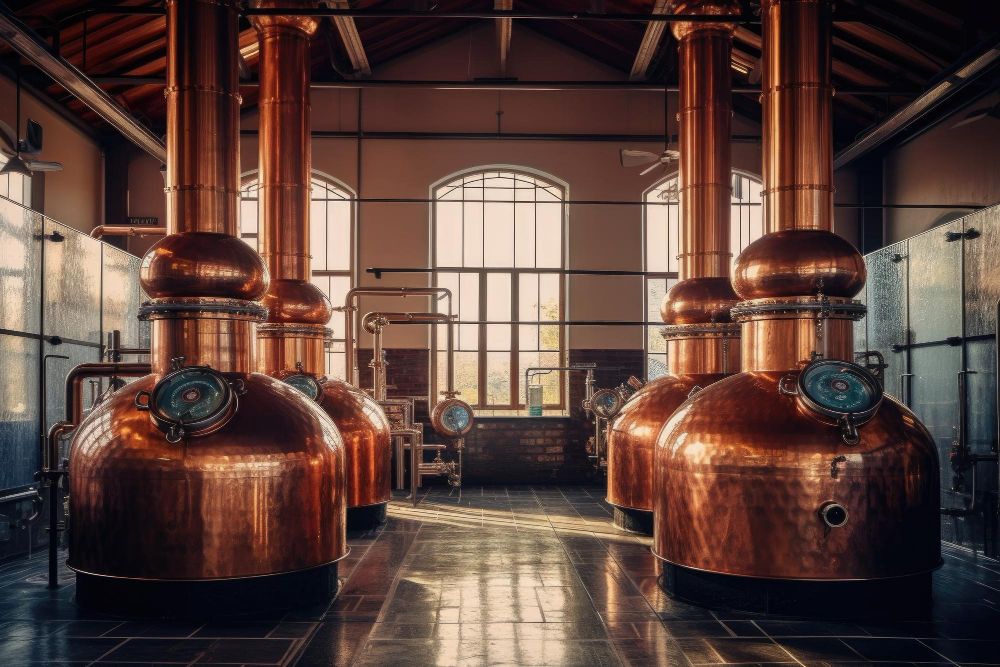Factors to Consider When Buying Stills Online
- 1 Top 4 Factors to Consider When Buying Stills Online
- 1.1 Understand Distillation
- 1.2 Decide How Many Plates You Want
- 1.3 Budget
- 1.4 Select a Reliable Source
- 2 Benefits of Using a distillery still
- 2.1 Purity and Concentration:
- 2.2 Flavor Profiling:
- 2.3 Consistency and Quality:
- 2.4 Efficiency in Production:
- 2.5 Versatility in Spirits Production:
- 2.6 Craftsmanship and Tradition:
- 2.7 Innovation and Experimentation:
- 3 Conclusion:
Your distillery’s still is its heart and soul. The kind and quantity of spirits you may manufacture on a daily, monthly, and annual basis will depend on your still. Additionally, as distillery tourism gains popularity, your architecture still contributes to a narrative that will inform and delight your audience, encouraging them to tell their friends and family about you. Your distillery journey continues after selecting the appropriate still type and size.
Top 4 Factors to Consider When Buying Stills Online
Understand Distillation
Typically, distillation takes place in a column where several cycles of condensation and evaporation are used to separate the alcohol from the wash. The boiling kettle releases alcohol vapor, which rises to the queue, passes through the bubble cap, and eventually hits the lower-proof alcohol bed on the plate, depending on where you are in the run. Heat disperses as the hot vapor touches the liquid bed, increasing the fluid bed’s temperature and producing additional steam.
Every plate experiences this phenomenon of heat transmission. The liquid is colder than the solid. Steam is hotter than water. As each dish is considered a cycle, the more refined ethyl alcohol turns into a vapor that will be condensed in the following cycle. The greater the purification, the more plate portions there are in each column.
Decide How Many Plates You Want
It is advised to have at least an 18-plate column if you plan to create vodka. Additional phase shifts are possible with other plates, which results in genuine, pure vodka. A longer run time is necessary when using multiple containers, though.
A smaller plate size is preferable to the whiskey manufacturers since their whiskey needs more taste than purity. No empirical research has demonstrated that the flavor of the finished product produced by a more extensive distillation apparatus is superior to that of a smaller one.
Budget
Budgeting for all the accessories, such as irrigation fittings, heating components, additional gaskets, and clamps, while purchasing equipment for alcohol distillation from a stills supplier may be highly time-consuming. Be cautious when the price looks too low since time is money. It can indicate shoddy welding, upcoming issues, and more maintenance expenses to maintain the machinery later on.
Remember to perform some math to determine the ideal equipment size per litter. A more extensive system that costs a bit more upfront could result in a better bottom line than a smaller investment, which occasionally costs more per litter. Achieving success requires finding a balance between equipment quality and affordability.
Select a Reliable Source
Another crucial element to success is finding a fantastic provider of equipment for craft distilleries. A reputable provider is well-versed in both their equipment and distillation in general. Any technical inquiries and recommendations on the appropriate equipment required for alcohol distillation in your handmade distillery should be addressed by your supplier. Although a more established firm does not always guarantee that it is the finest, it is a crucial indicator that it will be around in the long run.
Additionally, look at the stills supplier’s reputation. Check reviews from previous clients, get references, and obsess over their social media pages. Consider their customer support. They should be able to respond to inquiries and assist with distillery expansions in addition to continuously supporting their equipment.
Benefits of Using a distillery still
Purity and Concentration:
The primary function of a distillery is to separate and concentrate the desired components of a liquid through the process of distillation. This method, involving the heating and subsequent cooling of a liquid, allows for the extraction of pure alcohol or essential oils, resulting in a more concentrated and refined product.
Flavor Profiling:
Distillation is not merely about purification; it’s an art that allows for the nuanced control of flavors. Distillery stills enable producers to fine-tune the character of their spirits, capturing specific aromatic compounds and taste elements. This level of precision is crucial for creating a diverse range of spirits with distinct flavor profiles, from the smoky notes of some whiskies to the botanical bouquet of gin.
Consistency and Quality:
The distillery still plays a key role in maintaining consistency and quality across batches. Through careful monitoring and adjustment of the distillation process, producers can ensure that each bottle of their product meets the high standards expected by consumers. This reliability is essential in building brand reputation and consumer trust.
Efficiency in Production:
Distillation, when done with well-designed stills, can be a highly efficient process. Stills are engineered to optimize the separation of components, allowing for a streamlined production that maximizes output while maintaining the desired quality. This efficiency is especially crucial in large-scale distilleries where production volumes are substantial.
Versatility in Spirits Production:
Distillery stills are remarkably versatile, accommodating a wide range of spirits production. Whether crafting whiskey, vodka, rum, or essential oils, the same fundamental principles of distillation apply. This adaptability makes distillery stills an invaluable tool for producers seeking to diversify their product offerings.
Craftsmanship and Tradition:
While modern distilleries often incorporate cutting-edge technology, there remains an element of craftsmanship and tradition in their design. Many distillers take pride in the artistry of their stills, which can become iconic symbols of a distillery’s heritage and commitment to the craft.
Innovation and Experimentation:
Distillery stills are not static entities; they are platforms for innovation and experimentation. Distillers can push the boundaries of traditional methods, introducing new techniques and ingredients to create unique and groundbreaking spirits. This spirit of exploration keeps the industry dynamic and continually pushes the boundaries of what is possible in the world of distilled beverages.
Conclusion:
The distillery still stands as both a symbol of tradition and a vessel of innovation in the world of spirits production. From its role in purifying liquids to its ability to craft nuanced flavors, the distillery still is an essential tool for distillers dedicated to producing high-quality, distinctive beverages. As the art and science of distillation continue to evolve, the importance of well-designed and precisely engineered distilleries remains unwavering in the pursuit of liquid perfection.

















